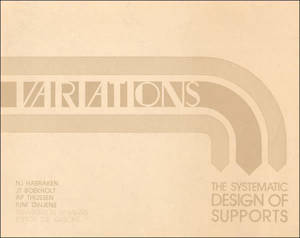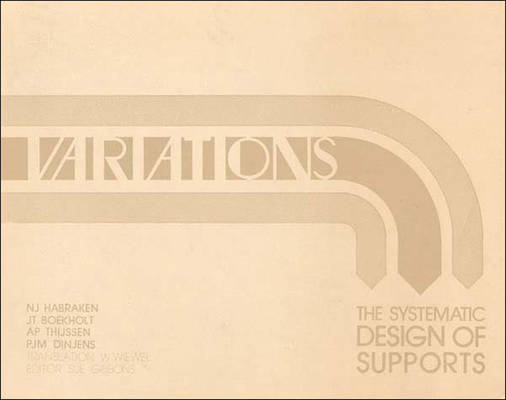
- Retrait gratuit dans votre magasin Club
- 7.000.000 titres dans notre catalogue
- Payer en toute sécurité
- Toujours un magasin près de chez vous
- Retrait gratuit dans votre magasin Club
- 7.000.000 titres dans notre catalogue
- Payer en toute sécurité
- Toujours un magasin près de chez vous
Variations
The Systematic Design of Supports
N J Habraken, J Th Boekholt, A P Thijssen, P J M Dinjens
114,95 €
+ 229 points
Description
First published in a Dutch edition in 1974, this book was written in Dutch by four members of the Design Methods Group of the Department of Architecture at the University of Eindhoven after several years of experience in teaching the method they developed and describe in the book. Since 1975 N. J. Habrakenhas been Head of the Department of Architecture at MIT. The other three authors are still teaching at Eindhoven. In an Introduction prepared for the English edition, Habraken writes that "It was hoped .. .that the design of supports would help solve some of the problems traditionally associated with the design of masshousing ... . It is not possible to evaluate the design of a support by examining the dwelling unit plan since there is no such predetermined plan. The support building must be judged in a different way. There is a PROBLEM OF EVALUATION when the support has to be judged on its potential for accommodating dwelling unit plans, which satisfy the individual requirements of different users, throughout its life span. To solve this problem a systematic way must be found to test the support by generating a series of representative possible floor plans and judging those by a set of general criteria. The method presented in this book provides tools to cope with the problem of evaluation . .. .The process of evaluation must test what is possible with in a given structure (e.g. the possible final floorplans) against what is generally desirable (e.g .specificaily stated standards). The method basically offers a series of operations that give, in increasingly complex situations, such comparisons. Given the width of a bay, what meaningful combinations of spaces or functions can be accommodated? In certain locations within a structure what kinds of activities are possible? Or conversely, given certain necessary relationships between functions, what bay width offers an optimum solution within certain technical and financial constraints? In what specific areas of a structure can certain desirable activities be located? The result of each separate operation within the method is always what is called a series of VARIATIONS, a number of possible solutions that give us the information we need to make decisions and proceed in the design process. In order to make the resultant variations comparable with others, that result from other operations, they must be generated in a systematic way. This means that the way we annotate the variations and the way that the system of annotation is arrived at must be formalized in order to avoid ambiguity."The first four chapters are devoted to a step-by-step description of the method, while later chapters show examples of possible applications and provide some explanation of the theoretical background. The contents are organized in such a way that the relationship between practical applications and theoretical background is made explicit. The book is profusely illustrated with plans and photographs of rooms and buildings. It is being distributed by The MIT Press for the MIT Laboratory of Architecture and Planning.
Spécifications
Parties prenantes
- Auteur(s) :
- Editeur:
Contenu
- Nombre de pages :
- 216
- Langue:
- Anglais
- Collection :
Caractéristiques
- EAN:
- 9780262580328
- Date de parution :
- 15-10-76
- Format:
- Livre broché
- Format numérique:
- Trade paperback (VS)
- Dimensions :
- 281 mm x 216 mm
- Poids :
- 607 g







